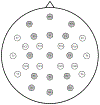Task modulates ERP effects of orthographic neighborhood for pseudowords but not words
- PMID: 30797831
- PMCID: PMC7045576
- DOI: 10.1016/j.neuropsychologia.2019.02.014
Task modulates ERP effects of orthographic neighborhood for pseudowords but not words
Abstract
Words and pseudowords from high-density orthographic neighborhoods elicit larger amplitude N400s than similar items from low-density orthographic neighborhoods in the lexical decision task. This pattern could be interpreted as an increase in the amount of lexico-semantic information to be processed or as an increase in difficulty identifying a word (or rejecting a pseudoword) amongst many co-activated alternatives. In order to dissociate between these mechanisms, we compared neighborhood effects between a lexical decision task (LDT) and a letter search task (LST). Behaviorally, we found the standard neighborhood and lexicality effects in the LDT, but no significant effects in the LST. Thus, behavioral responses were sensitive to the decisions required by the respective tasks. Electrophysiologically, we found similar N400 neighborhood effects between tasks for words, but the N400 neighborhood effect for pseudowords was only present in the LDT. Moreover, the effect of neighborhood in the LDT occurred earlier for words than for pseudowords. These nuanced differences in the time course and automaticity of word and pseudoword neighborhood effects lend insight into the processes that underlie N400 effects of orthographic neighborhood and how they unfold over time. We propose that the early neighborhood effects for words across tasks were driven by highly automatized word identification processes that were sensitive to the lateral inhibition generated by orthographic neighbors. In contrast, the later neighborhood effects for pseudowords in the LDT could have been driven by task-specific processes tied to how global lexical activity is used to make a lexical decision.
Keywords: ERPs; Lexical status; N400; Orthographic neighborhood; Task effects.
Copyright © 2019 Elsevier Ltd. All rights reserved.
Figures







Similar articles
-
ERP correlates of letter identity and letter position are modulated by lexical frequency.Brain Lang. 2013 Apr;125(1):11-27. doi: 10.1016/j.bandl.2012.12.009. Epub 2013 Feb 26. Brain Lang. 2013. PMID: 23454070 Free PMC article.
-
Orthographic and associative neighborhood density effects: what is shared, what is different?Psychophysiology. 2010 May 1;47(3):455-66. doi: 10.1111/j.1469-8986.2009.00960.x. Epub 2010 Jan 19. Psychophysiology. 2010. PMID: 20102534
-
Top-down modulation of brain responses in spelling error recognition.Acta Psychol (Amst). 2023 May;235:103891. doi: 10.1016/j.actpsy.2023.103891. Epub 2023 Mar 16. Acta Psychol (Amst). 2023. PMID: 36933384
-
An electrophysiological study of the effects of orthographic neighborhood size on printed word perception.J Cogn Neurosci. 2002 Aug 15;14(6):938-50. doi: 10.1162/089892902760191153. J Cogn Neurosci. 2002. PMID: 12191460
-
Word and pseudoword superiority effects reflected in the ERP waveform.Brain Res. 2010 May 6;1329:159-74. doi: 10.1016/j.brainres.2010.02.084. Epub 2010 Mar 6. Brain Res. 2010. PMID: 20211607 Free PMC article.
Cited by
-
Event-related potentials for investigating the willingness to recycle household medical waste.Heliyon. 2023 Oct 5;9(10):e20722. doi: 10.1016/j.heliyon.2023.e20722. eCollection 2023 Oct. Heliyon. 2023. PMID: 37842614 Free PMC article.
-
Orthographic neighborhood density modulates the size of transposed-letter priming effects.Cogn Affect Behav Neurosci. 2021 Oct;21(5):948-959. doi: 10.3758/s13415-021-00905-w. Epub 2021 May 6. Cogn Affect Behav Neurosci. 2021. PMID: 33954926
-
An ERP investigation of orthographic precision in deaf and hearing readers.Neuropsychologia. 2020 Sep;146:107542. doi: 10.1016/j.neuropsychologia.2020.107542. Epub 2020 Jun 24. Neuropsychologia. 2020. PMID: 32590018 Free PMC article.
-
Spatiotemporal dynamics of orthographic and lexical processing in the ventral visual pathway.Nat Hum Behav. 2021 Mar;5(3):389-398. doi: 10.1038/s41562-020-00982-w. Epub 2020 Nov 30. Nat Hum Behav. 2021. PMID: 33257877 Free PMC article.
-
The organization of the American Sign Language lexicon: Comparing one- and two-parameter ERP phonological priming effects across tasks.Brain Lang. 2021 Jul;218:104960. doi: 10.1016/j.bandl.2021.104960. Epub 2021 Apr 30. Brain Lang. 2021. PMID: 33940343 Free PMC article.
References
-
- Andrews S (1997). The effect of orthographic similarity on lexical retrieval: Resolving neighborhood conflicts. Psychonomic Bulletin & Review,. 4(4), 439–461. doi:10.3758/BF03214334 - DOI
Publication types
MeSH terms
Grants and funding
LinkOut - more resources
Full Text Sources

